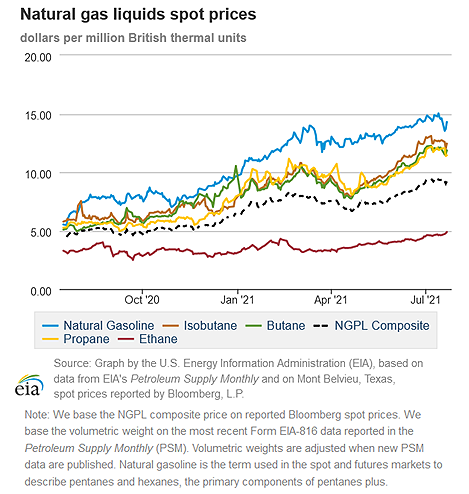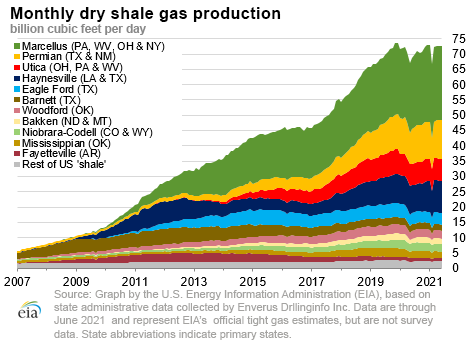In the News:
U.S. liquefied natural gas exports were at record high levels in the first half of 2021
U.S. exports of liquefied natural gas (LNG) continued to grow in the first six months of 2021, averaging 9.5 billion cubic feet per day (Bcf/d). This average marks an increase of 41%, or 2.8 Bcf/d, compared with the same period in 2020, according to the U.S. Department of Energy’s LNG Monthly reports and our estimates for June 2021, based on shipping data from Bloomberg Finance L.P. In the summer months of 2020, U.S. LNG exports fell to record lows, but then they set consecutive record highs in November and December.
U.S. LNG exports increased in the first half of this year because of an increase in international natural gas and LNG spot prices in Asia and Europe, an increase in global LNG demand following easing of COVID-19 restrictions, and continuous unplanned outages at LNG export facilities in several countries, including Australia, Malaysia, Nigeria, Algeria, Norway, and Trinidad and Tobago.
In Asia, colder-than-normal winter temperatures led to increased demand for spot LNG imports. Natural gas demand in the spring continued to rise amid low post-winter inventories, which contributed to unseasonably high natural gas prices, attracting higher volumes of flexible LNG supplies, particularly from the United States.
In Europe, natural gas storage inventories were also low following a cold winter. Increasingly hot temperatures in May and June and higher natural gas demand from the electric power sector contributed to high natural gas spot prices. Europe’s natural gas spot prices have historically been lower than prices in Asia; however, this year, Europe’s natural gas prices are tracking Asia’s spot LNG prices more closely to attract flexible LNG supplies from around the world to refill storage inventories.
The U.S. Henry Hub natural gas benchmark and U.S. LNG spot market prices have been lower than international natural gas and LNG spot prices this year, which has supported record-high volumes of U.S. LNG exports. U.S. LNG exports also increased because of new export capacity added in 2020. The final liquefaction units were commissioned at Freeport, Cameron, and Corpus Christi LNG, and the remaining small-scale units were placed in service at Elba Island LNG, increasing total U.S. LNG peak export capacity by a combined 2.3 Bcf/d for a total of 10.8 Bcf/d.
As in 2020, Asia remained the main destination for U.S. LNG exports from January through May 2021, accounting for 46% of the total, followed by Europe with a five-month average share of 37%. Exports to Latin America also increased, particularly to Brazil, which is experiencing its worst drought in more than 90 years.
In June, U.S. LNG exports declined slightly, mainly as a result of maintenance on several pipelines that deliver natural gas to U.S. LNG export facilities. Yet, we expect LNG exports to remain at high levels in the remaining months of this year in our Short-Term Energy Outlook.
Overview:
(For the week ending Wednesday, July 21, 2021)
- Natural gas spot price movements were mixed this report week (Wednesday, July 14 to Wednesday, July 21). The Henry Hub spot price rose from $3.75 per million British thermal units (MMBtu) last Wednesday to $3.91/MMBtu yesterday.
- The price of the August 2021 NYMEX contract increased 30¢, from $3.660/MMBtu last Wednesday to $3.959/MMBtu yesterday. The price of the 12-month strip, averaging August 2021 through July 2022 futures contracts, climbed 22¢/MMBtu to $3.693/MMBtu.
- The net injections to working gas totaled 49 billion cubic feet (Bcf) for the week ending July 16. Working natural gas stocks totaled 2,678 Bcf, which is 17% lower than the year-ago level and 6% lower than the five-year (2016–2020) average for this week.
- The natural gas plant liquids composite price at Mont Belvieu, Texas, fell by 10¢/MMBtu, averaging $9.23/MMBtu for the week ending July 21. This price drop followed declines in weekly average crude oil prices, which fell 6% week over week. Propane prices fell 1%, a smaller decline than the decrease in the crude oil price, and current propane inventories are now at the bottom of the five-year range for this week of the year. Normal butane and isobutane prices fell by 2% and 1%, respectively, also a smaller decline than the decrease in the crude oil price, reflecting relatively low inventories and continued robust export activity since last year. Natural gasoline prices, which most closely follow crude oil prices, fell 4%. Ethane prices rose 2%, supported by rising prices of ethylene, a basic chemical produced primarily from ethane, which had a 4% price increase week over week.
- According to Baker Hughes, for the week ending Tuesday, July 13, the natural gas rig count increased by 3 to 104, with the largest gains in the Eagle Ford play in South Texas. The number of oil-directed rigs rose by 2 to 380, led by a gain of 3 rigs in Wyoming offset by declines elsewhere. The total rig count increased by 5, and it now stands at 484.
Prices/Supply/Demand:
Gulf Coast prices increase again this week. This report week (Wednesday, July 14 to Wednesday, July 21), the Henry Hub spot price rose 16¢ from $3.75/MMBtu last Wednesday to $3.91/MMBtu yesterday, its highest level since March 2019, excluding the February 2021 price spike. Natural gas consumed in the power sector in the Southeast increased 2.7% this week, according to data from IHS Markit.
High demand and supply constraints cause prices to increase further this week in the West. The price at PG&E Citygate in Northern California rose 34¢, up from $5.02/MMBtu last Wednesday to $5.36/MMBtu yesterday. The price at SoCal Citygate in Southern California increased $1.07 from $6.45/MMBtu last Wednesday to $7.52/MMBtu yesterday. The price spread between SoCal Citygate and the Waha hub, located near the Permian Basin, also increased, up from $3.06/MMBtu last week to $3.78/MMBtu this week. Maintenance on the El Paso pipeline is limiting flows of natural gas from the Permian Basin to the West, where consumption of natural gas remains elevated in the electric power sector for cooling.
Midwest prices increase along with consumption in the electric power sector. At the Chicago Citygate, the price increased 20¢ from $3.56/MMBtu last Wednesday to $3.76/MMBtu yesterday. The Natural Gas Intelligence Midwest Regional Average reported price also increased 20¢ from $3.51/MMBtu to $3.71/MMBtu. Consumption of natural gas in the electric power sector increased 8.8% this week in the Midwest, according to data from IHS Markit.
Increased supply into the Northeast and milder temperatures put downward pressure on prices in the region. At the Algonquin Citygate, which serves Boston-area consumers, the price went down 27¢, from $3.54/MMBtu last Wednesday to $3.27/MMBtu yesterday. At the Transcontinental Pipeline Zone 6 trading point for New York City, the price decreased 36¢, from $3.63/MMBtu last Wednesday to $3.27/MMBtu yesterday. Flows of natural gas from the Appalachia region to New York and New Jersey increased 4.1%, according to data from IHS Markit, increasing total supply in the region. The Appalachia region is experiencing constraints moving natural gas South and West out of the region because of pipeline maintenance and operational issues (see Appalachia section), which is freeing up supplies to move along available outlets into the Northeast.
Pipeline constraints lower prices in the Appalachia Basin. The Tennessee Zone 4 Marcellus spot price decreased 15¢, from $3.05/MMBtu last Wednesday to $2.90/MMBtu yesterday. The price at Eastern Gas South in Southwestern Pennsylvania fell 8¢ from $3.12/MMBtu last Wednesday to $3.04/MMBtu yesterday. Operational issues at the Chandlersville compressor station (Notice ID 9019) on the Rockies Express pipeline (REX) and planned maintenance on the Columbia Gas Transmission pipeline at the SM-80 Loop and MXP locations are limiting natural gas flows out of the Appalachia region into the Midwest and the South, respectively.
Low wind generation boosts consumption of natural gas in the electric power sector in Texas, increasing natural gas prices. The price at the Waha Hub in West Texas, which is located near Permian Basin production activities, rose 35¢, from $3.39/MMBtu last Wednesday to $3.74/MMBtu yesterday. The price increase, which was larger than the price increase at the Henry Hub, resulted in the Waha price discount relative to the Henry Hub declining from 36¢/MMBtu last Wednesday to 17¢/MMBtu yesterday. Prices at other Texas hubs also increased week over week. The natural gas price at the Houston Ship Channel increased 14¢, from $3.74/MMBtu to $3.88/MMBtu, and the price at the Katy Hub increased 28¢, from $3.59/MMBtu to $3.87/MMBtu. Prices at both hubs were at their highest since February 19. Natural gas consumed in the electric power sector in Texas increased 5.7% this week, according to data from IHS Markit, because of a decrease in electricity generation from wind.
Prices in Western Canada rise as another heat wave moves into the region. The price at NOVA/AECO, the main natural gas pricing hub in Alberta, Canada, rose 16¢, from $3.71/MMBtu last Wednesday to $3.87/MMBtu yesterday, approaching the highest price. The current high for the year was set in the last week of June, when the previous heat wave in the region resulted in record-setting temperatures. IHS Markit reports elevated in-region demand and lower outflows as a result of higher electricity demand in the region. Amid the heat wave, the price at the Sumas Hub on the Washington-Canada border rose 46¢ this week to $3.76/MMBtu yesterday.
U.S. total supply of natural gas declines slightly this week. According to data from IHS Markit, the average total supply of natural gas fell by 0.1% compared with the previous report week. Dry natural gas production grew by 0.1% compared with the previous report week to average 92.9 billion cubic feet per day (Bcf/d). Average net imports from Canada decreased by 3.0% from last week to 5.0 Bcf/d.
U.S. consumption of natural gas in the electric power sector drives total consumption higher. Total U.S. consumption of natural gas rose by 1.5% compared with the previous report week, according to data from IHS Markit. Natural gas consumed for power generation climbed by 3.3% week over week as much of the West and Northern Plains continued to experience higher-than-normal temperatures. Industrial sector consumption decreased by 1.0% week over week. In the residential and commercial sectors, consumption declined by 0.2%. Natural gas exports to Mexico decreased 2.3% to average 6.3 Bcf/d. Natural gas deliveries to U.S. liquefied natural gas (LNG) export facilities (LNG pipeline receipts) averaged 10.4 Bcf/d, or 0.33 Bcf/d lower than last week.
U.S. LNG exports increase week over week. Twenty-one LNG vessels (six from Sabine Pass, five from Freeport, four from Corpus Christi, three from Cameron, two from Cove Point, and one from Elba Island) with a combined LNG-carrying capacity of 76 Bcf departed the United States between July 15 and July 21, 2021, according to shipping data provided by Bloomberg Finance, L.P.
Storage:
The net injections into storage totaled 49 Bcf for the week ending July 16, compared with the five-year (2016–2020) average net injections of 36 Bcf and last year's net injections of 38 Bcf during the same week. Working natural gas stocks totaled 2,678 Bcf, which is 176 Bcf lower than the five-year average and 532 Bcf lower than last year at this time.
According to The Desk survey of natural gas analysts, estimates of the weekly net change to working natural gas stocks ranged from net injections of 30 Bcf to 51 Bcf, with a median estimate of 44 Bcf.
The average rate of injections into storage is 14% lower than the five-year average so far in the refill season (April through October). If the rate of injections into storage matched the five-year average of 8.1 Bcf/d for the remainder of the refill season, the total inventory would be 3,543 Bcf on October 31, which is 176 Bcf lower than the five-year average of 3,719 Bcf for that time of year.
More storage data and analysis can be found on the Natural Gas Storage Dashboard and the Weekly Natural Gas Storage Report.
See also:
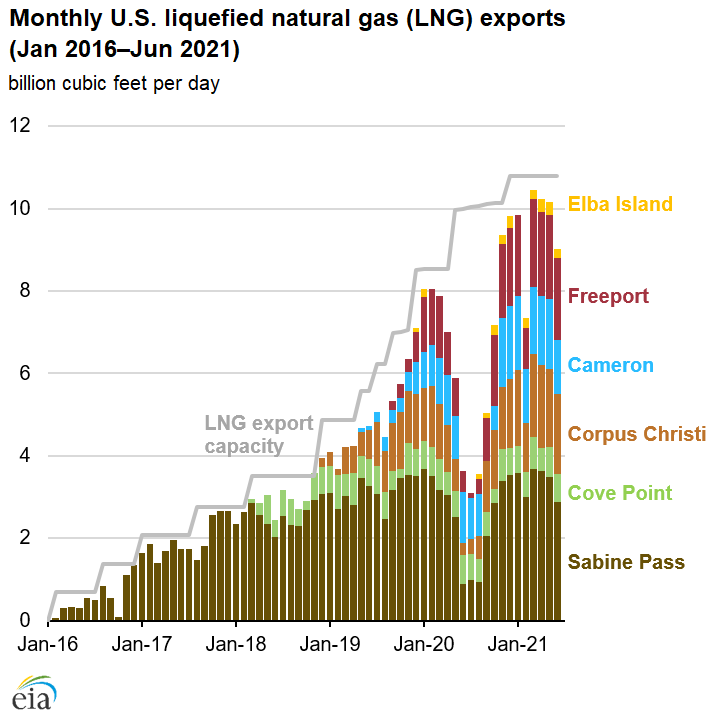 Source: Graph by the U.S. Energy Information Administration (EIA), based on data from the U.S. Department of Energy’s LNG Monthly, EIA’s estimates for June 2021, and EIA’s Liquefaction Capacity Table
Source: Graph by the U.S. Energy Information Administration (EIA), based on data from the U.S. Department of Energy’s LNG Monthly, EIA’s estimates for June 2021, and EIA’s Liquefaction Capacity Table
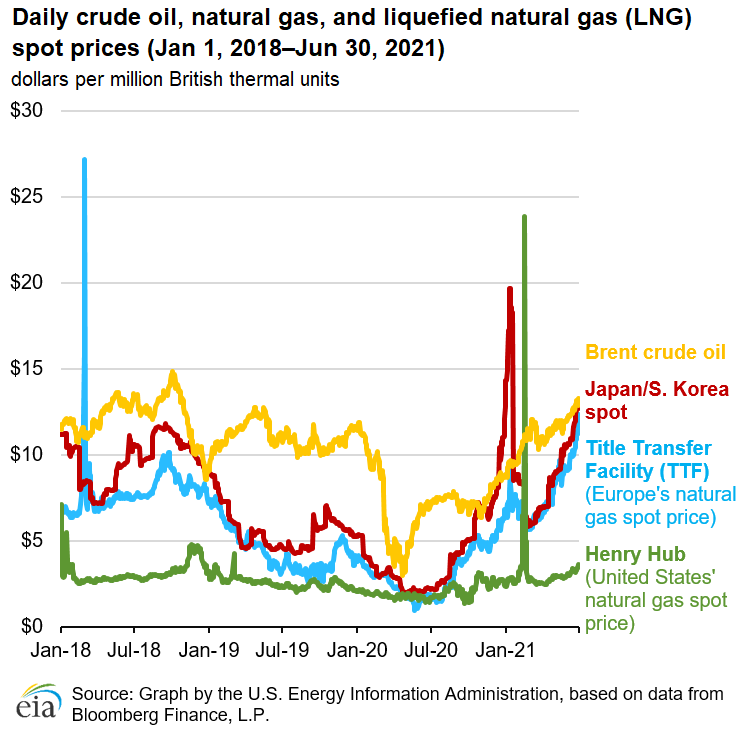
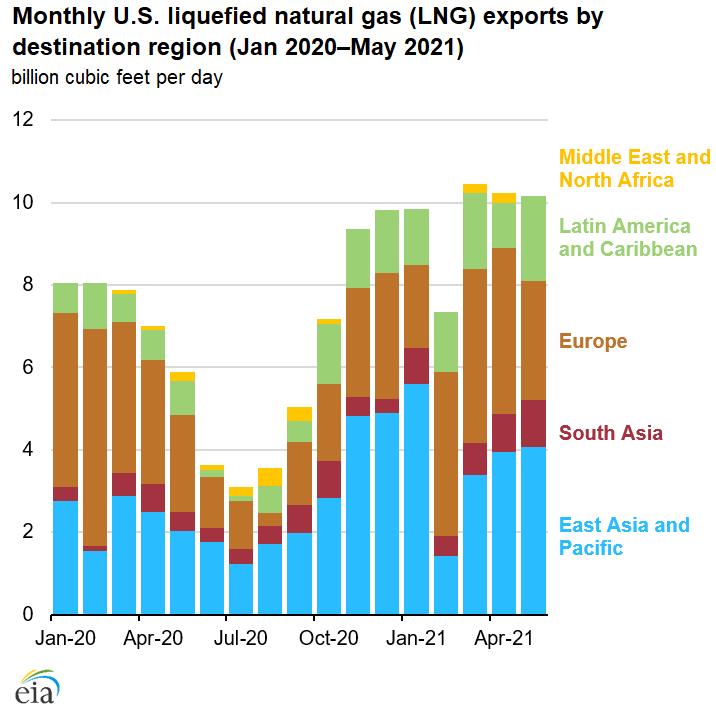 Source: Graph by the U.S. Energy Information Administration (EIA), based on data from the U.S. Department of Energy’s LNG Monthly reports.
Source: Graph by the U.S. Energy Information Administration (EIA), based on data from the U.S. Department of Energy’s LNG Monthly reports.
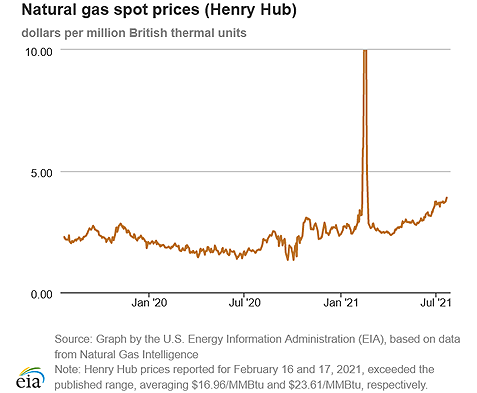
| Spot Prices ($/MMBtu) | Thu, 15-Jul |
Fri, 16-Jul |
Mon, 19-Jul |
Tue, 20-Jul |
Wed, 21-Jul |
|---|---|---|---|---|---|
| Henry Hub |
3.69 |
3.69 |
3.75 |
3.83 |
3.91 |
| New York |
3.68 |
3.40 |
3.46 |
3.29 |
3.27 |
| Chicago |
3.48 |
3.47 |
3.65 |
3.68 |
3.76 |
| Cal. Comp. Avg.* |
4.56 |
4.30 |
5.03 |
5.03 |
5.00 |
| Futures ($/MMBtu) | |||||
| August contract | 3.614 |
3.674 |
3.779 |
3.876 |
3.959 |
| September contract |
3.601 |
3.658 |
3.754 |
3.852 |
3.938 |
| *Avg. of NGI's reported prices for: Malin, PG&E Citygate, and Southern California Border Avg. | |||||
| Source: NGI's Daily Gas Price Index | |||||
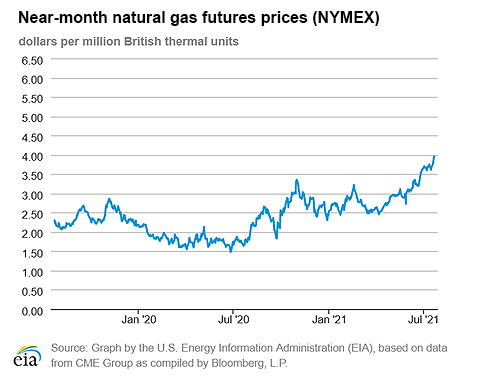
| U.S. natural gas supply - Gas Week: (7/15/21 - 7/21/21) | |||
|---|---|---|---|
Average daily values (billion cubic feet) |
|||
this week |
last week |
last year |
|
| Marketed production | 105.0 |
104.9 |
100.6 |
| Dry production | 92.9 |
92.9 |
89.2 |
| Net Canada imports | 5.0 |
5.2 |
4.4 |
| LNG pipeline deliveries | 0.1 |
0.1 |
0.2 |
| Total supply | 98.0 |
98.1 |
93.8 |
|
Source: Chart by the U.S. Energy Information Administration (EIA), based on data from IHS Markit | |||
| U.S. natural gas consumption - Gas Week: (7/15/21 - 7/21/21) | |||
|---|---|---|---|
Average daily values (billion cubic feet) |
|||
this week |
last week |
last year |
|
| U.S. consumption | 66.7 |
65.7 |
73.5 |
| Power | 38.6 |
37.3 |
44.9 |
| Industrial | 20.3 |
20.5 |
20.6 |
| Residential/commercial | 7.9 |
7.9 |
8.0 |
| Mexico exports | 6.3 |
6.5 |
6.0 |
| Pipeline fuel use/losses | 6.3 |
6.3 |
6.4 |
| LNG pipeline receipts | 10.4 |
10.8 |
3.7 |
| Total demand | 89.8 |
89.2 |
89.5 |
|
Source: Chart by the U.S. Energy Information Administration (EIA), based on data from IHS Markit | |||
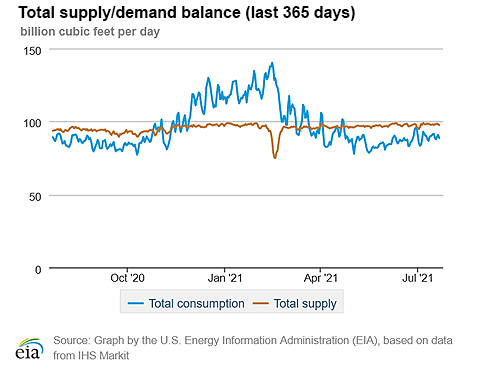
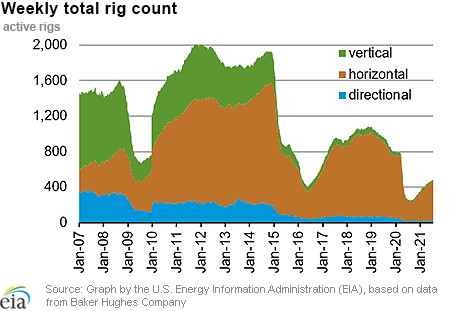
| Rigs | |||
|---|---|---|---|
Tue, July 13, 2021 |
Change from |
||
last week |
last year |
||
| Oil rigs | 380 |
0.5% |
111.1% |
| Natural gas rigs | 104 |
3.0% |
46.5% |
| Note: Excludes any miscellaneous rigs | |||
| Rig numbers by type | |||
|---|---|---|---|
Tue, July 13, 2021 |
Change from |
||
last week |
last year |
||
| Vertical | 18 |
20.0% |
20.0% |
| Horizontal | 434 |
0.2% |
101.9% |
| Directional | 32 |
3.2% |
39.1% |
| Source: Chart by the U.S. Energy Information Administration (EIA), based on data from Baker Hughes Company | |||
| Working gas in underground storage | ||||
|---|---|---|---|---|
Stocks billion cubic feet (Bcf) |
||||
| Region | 2021-07-16 |
2021-07-09 |
change |
|
| East | 562 |
543 |
19 |
|
| Midwest | 683 |
662 |
21 |
|
| Mountain | 183 |
180 |
3 |
|
| Pacific | 247 |
250 |
-3 |
|
| South Central | 1,002 |
995 |
7 |
|
| Total | 2,678 |
2,629 |
49 |
|
|
Source: U.S. Energy Information Administration Form EIA-912, Weekly Underground Natural Gas Storage Report | ||||
| Working gas in underground storage | |||||
|---|---|---|---|---|---|
Historical comparisons |
|||||
Year ago (7/16/20) |
5-year average (2016-2020) |
||||
| Region | Stocks (Bcf) |
% change |
Stocks (Bcf) |
% change |
|
| East | 690 |
-18.6 |
618 |
-9.1 |
|
| Midwest | 796 |
-14.2 |
697 |
-2.0 |
|
| Mountain | 189 |
-3.2 |
178 |
2.8 |
|
| Pacific | 311 |
-20.6 |
290 |
-14.8 |
|
| South Central | 1,222 |
-18.0 |
1,071 |
-6.4 |
|
| Total | 3,210 |
-16.6 |
2,854 |
-6.2 |
|
| Source: U.S. Energy Information Administration Form EIA-912, Weekly Underground Natural Gas Storage Report | |||||
| Temperature – heating & cooling degree days (week ending Jul 15) | ||||||||
|---|---|---|---|---|---|---|---|---|
HDDs |
CDDs |
|||||||
| Region | Current total |
Deviation from normal |
Deviation from last year |
Current total |
Deviation from normal |
Deviation from last year |
||
| New England | 1 |
0 |
1 |
37 |
-3 |
-39 |
||
| Middle Atlantic | 0 |
-1 |
0 |
70 |
14 |
-14 |
||
| E N Central | 5 |
4 |
5 |
45 |
-11 |
-28 |
||
| W N Central | 2 |
-1 |
1 |
52 |
-18 |
-26 |
||
| South Atlantic | 0 |
0 |
0 |
103 |
7 |
-7 |
||
| E S Central | 0 |
0 |
0 |
91 |
-2 |
-9 |
||
| W S Central | 0 |
0 |
0 |
107 |
-16 |
-40 |
||
| Mountain | 0 |
-5 |
-1 |
96 |
19 |
-2 |
||
| Pacific | 0 |
-4 |
-2 |
72 |
31 |
17 |
||
| United States | 1 |
0 |
1 |
77 |
4 |
-14 |
||
|
Source: Chart by the U.S. Energy Information Administration (EIA), based on data from the National Oceanic and Atmospheric Administration Note: HDDs=heating degree days; CDDs=cooling degree days | ||||||||
Average temperature (°F)
7-day mean ending Jul 15, 2021
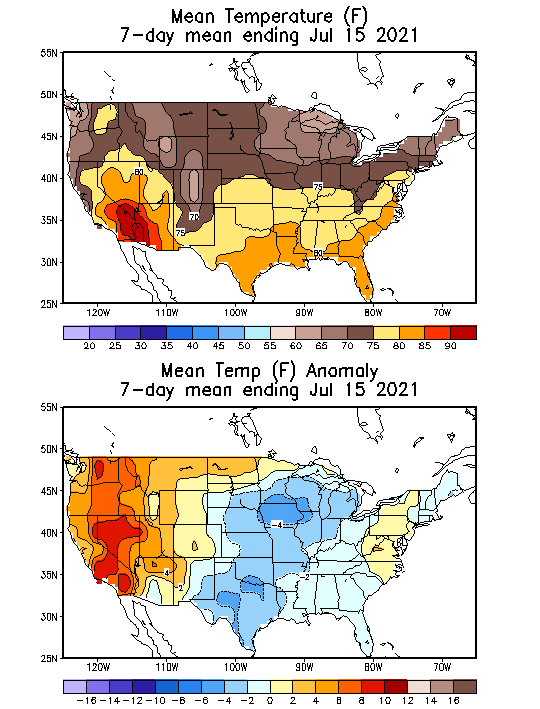
Source: National Oceanic and Atmospheric Administration
Deviation between average and normal (°F)
7-day mean ending Jul 15, 2021

Source: National Oceanic and Atmospheric Administration

